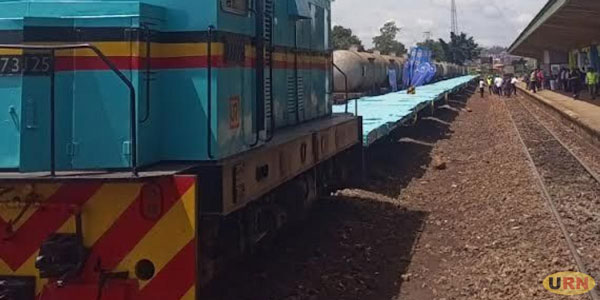
Kampala, Uganda | THE INDEPENDENT | Uganda Railways Corporation has received 20 refurbished flatbed wagons which will be used to revive the Kampala-Dar-es-Salaam route.
The wagons were refurbished by a Ugandan company; MOFR Engineering Solutions Ltd at a cost of just over 1 billion Shillings (288,000 US Dollars) provided by the Central Corridor Transit Transport Facilitation Agency (CCTTFA).
Works and Transport Minister General Edward Katumba Wamala said they aim to increase railway cargo transportation from the current 40,000 to 200,000 tons a year in at least two years. Currently, about 90 per cent of the cargo destined to and through Uganda is moved on the road, the most expensive means of transport, both to the business community and to the government in the form of infrastructure maintenance.
He urged the business community to embrace the railway system which would help to lower the cost of doing business in the country.
However, the transporters and importers, who welcomed the new investment in the southern corridor, complained that the railway tariff is still too high compared to the Mombasa route, despite all the incentives that the government of Tanzania has offered.
Stuart Mwesigwa, the Director of Business Management at Roofings, the biggest single customer of Uganda Railways, says the agency is increasing capacity but so is the private sector’s demand for the services. He called for a reduction in the tariffs, especially as the clientele of Uganda Railways is increasing.
Katumba Wamala assured the private sector that once the infrastructure improves and the usage by the private sector increases on the railway system, the costs will automatically come down because it will be easier then, for URC to fund the operations.
The private sector also urged the two governments to work on the other challenges that affect the development of trade between Uganda and Tanzania, especially communication and the acquisition of work permits.
William Busulwa, the Chairman of Uganda National Transport Alliance said that for as long as it is hard to call from Tanzania to Uganda on the phone and even for Ugandans to acquire work permits in Tanzania, among other challenges, trade will remain low.
Wamala added that currently, they are implementing plans to increase the capacity of water transport between Mwanza in Tanzania, and Kampala and Jinja because, without that, the railway line from the coast to Lake Victoria will be meaningless.
The plans include the renovation of MV Kaawa which is due to be docked soon for the repairs. The Minister also said they have engaged experts to retrieve MV Kabalega which sank in 2005. The Executive Secretary of CCTTFA, Flory Okonge Okandju urged Uganda to speed up its infrastructure program especially along the central corridor, to make the system complete.
He hailed Tanzania for its investments in water and railway transport projects, urging Uganda to do the same, to avoid cargo clogging the ports because it cannot be evacuated.
Minister Wamala agreed that a lot needs to be done to ensure that the ports on the lake and within Uganda do not choke with cargo, but added that the private sector should also step up their use of the railway network because currently, it is underutilized.
The Ugandan officials called on the CCTTFA to extend their financial help to the rehabilitation of more equipment, with the URC saying there are about 500 pieces that are lying in the yards.
Sarah Nambasa, the Corporation Secretary of URC said the wagons will go a long way in improving cargo movement options for Ugandans, adding that they are working on other facilities to support the expected increase in cargo by train. These, according to her, include the turning of the Kampala Goods Shed into an inland depot.
*****
URN
 The Independent Uganda: You get the Truth we Pay the Price
The Independent Uganda: You get the Truth we Pay the Price



